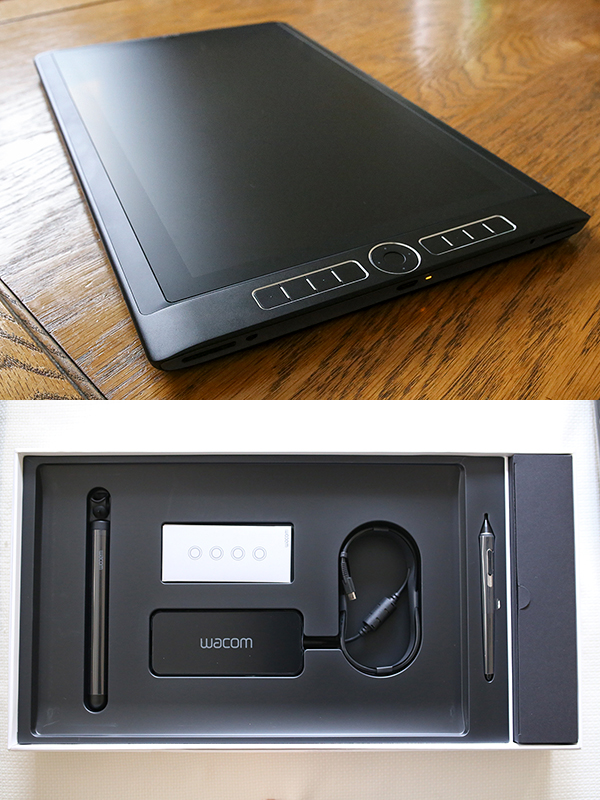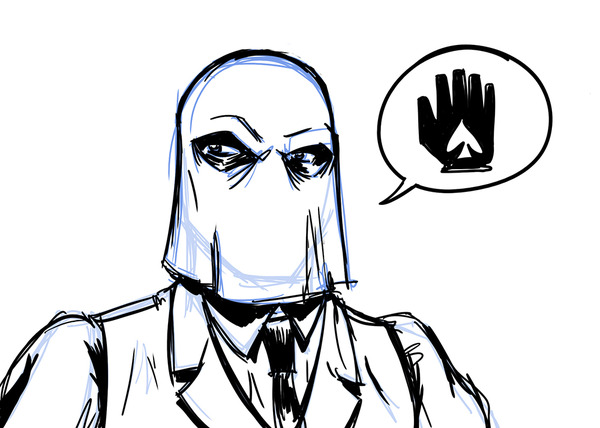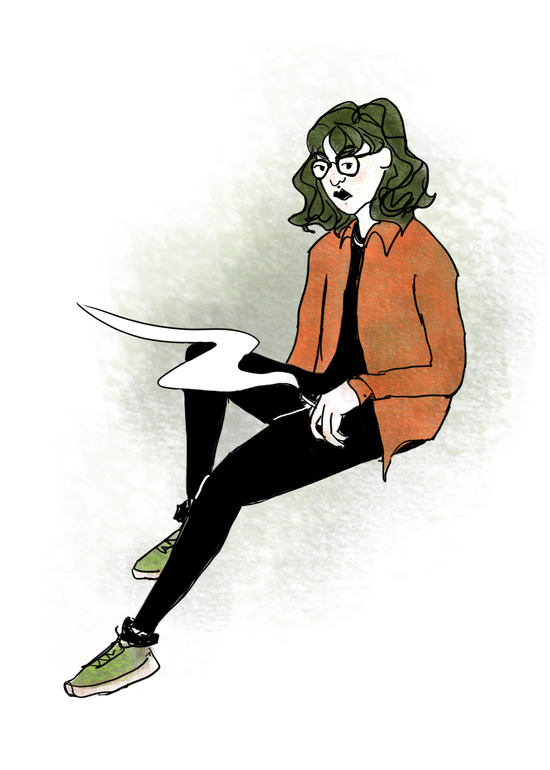Exploring Pixel vs. Paper with Wacom’s MobileStudio Pro, the Bentley of Drawing Tablets
Comics Features Wacom
Last October at New York City Comic Con, I hosted a panel with five professional cartoonists. At one point, we tripped on the topic of process, and specifically what tools they used. All but one (Hippopotamister/Teen Boat creator John Green, for those curious) used a Cintiq, a screen that records pen movements as pixels. The four artists told the same story: illustrating pages takes time, and time is money. Scanning art from paper was an extra step that took more time. Using tablets and screens was a pragmatic alternative, and whatever may be sacrificed, if anything, wasn’t enough to warrant the extra effort.
Anecdotally, it’s hard to think that the vast majority of cartoonists and professional illustrators aren’t switching to digital tools, if they didn’t already years ago. But certain populations still hold fast to their watercolors and lead—especially in independent comics. In an interview with Simon Hanselmann, the creator of Megahex, he stated that “computers never touch my pages. What you see on the page in the book is what the page looks like in real life…Michael DeForge is one of the very few people who works digitally whose work I can stand. It just seems like cheating to me. It’s too easy, too fast. I like sweating over and onto my pages. I like the physical object of the page. I like the danger. If I make a mistake on the page, it’s very difficult to fix.”
That same convention, I began to chat with the folks at Wacom, a company that holds a tight grasp on the market of tablets and peripherals for illustrators. Their newest marquee tool was the MobileStudio Pro, a $2,000-to-$3,000 slab of computing horsepower overlaid with a touchscreen. It’s a computer on its own that can house an array of software, but operates solely via touch either through a sophisticated pen or unsophisticated finger (a keyboard peripheral is also available). The “pen computer” promises the crux of technology-aided drawing, and more—it includes a camera for 3D rendering. It asks the question whether illustration needs to be evaluated under the lens of pencil and paper. If we transported an Egyptian scribe from 200 BCE and presented them with a no. 2 and a notebook, would they complain that the paper lacked the fibrous grooves of papyrus? In parallel, should we expect the ice-skate glide of a modern tablet to simulate the tactility of lead on paper?

The 16” MobileStudio Pro and box contents from Paste’s review copy
We decided to explore this question through a review copy of a 16” MobileStudio Pro. Two comics pros were kind enough to weigh in; nobody knows the subtleties of process more than people who draw everyday for their livelihood. Carver: A Paris Story cartoonist Chris Hunt has years of experience with a Cintiq, while Lauren McCallister is new to the tablet world. They both included illustrations rendered on the unit.
A few thoughts on Paste’s end (via Sean, a professional photographer who dabbles in design and owns an Intuos touch tablet): this thing is damn powerful. It has 512 GB of space, 16 GB of RAM and a 2560 × 1440 display. The pen, which doesn’t require a battery, can simulate 8,192 levels of pressure. Along with an Intel Core i7 processor, its specs aren’t dissimilar from the most powerful MacBook Pro available. The real question comes from what creating a hybrid computer/touchscreen of this magnitude might leave out, and the answer is hot keys from a keyboard. The model attempts to compensate with eight programmable buttons located on the side of the unit, along with a multi-purpose wheel. If there’s one criticism, it’s that this solution still feels inelegant; the programming used to map functions to the buttons isn’t context sensitive. Using two buttons for forward and back (selected from a list) will work on browsers, but it won’t, say, translate to a similar function like undo and redo in Photoshop.
The more a user dives into the MobileStudio Pro, the more they’ll work out any rough corners, but being able to quickly and intuitively navigate a program without slogging through menus is a key hurdle. The irony is that Apple already provided a solution to this quandary with their context sensitive Touch Bar—shortcuts change depending on the program selected. The hardware could certainly handle the load of this feature and it will also open up some screen real estate, and I’d rather trust your programmers to handle it than resort to third party options.
And as many have pointed out, why, oh why, are there no carrying cases or (in-stock) stands designed for the MobileStudio Pro, either from Wacom or third party? People are posting videos about clever substitutions, but with marketing copy that touts “designed to give you the freedom to create anywhere,” having a way to safely transport a $3,000 touchscreen computer isn’t too much to ask. It’s a gorgeous, sophisticated piece of machinery that meets the overwhelming majority of its expectations. We just want to treat it right.
![]()

Chris Hunt, Cartoonist of Carver: A Paris Story
Upon completing my first full-length graphic novel last year, Carver: A Paris Story, I felt that I had reached that point of mastery with the brush where I could begin to take a serious look at digital. I had begun to see artists whom I greatly admired make the switch—namely, Becky Cloonan—and I saw that it was at least possible to translate what I had learned to a new tool. Over the past year I have incorporated not only Wacom’s 13-inch Cintiq into my workflow, but also the 9-inch iPad Pro.
This brings us to Wacom’s newest device, the MobileStudio Pro. The model I handled was their largest, the 16-inch, and it is substantial to say the least. Despite one of the selling points of this new machine being its ability to work untethered from a conventional work station, I cannot conceive of the individual who would carry something so unwieldy (and expensive) out into the world. This is compounded by the fact that there are zero options for cases or covers currently.
If you’ve used a Cintiq, then much of what you have come to expect from Wacom is present here. There are the same optional buttons for hot keys on the tablet, and a welcomed return of the rotational “touch wheel,” something that was invaluable to me on my Intuos but is frustratingly lacking on my 13-inch Cintiq. Wacom’s new flagship is also very fast. I use Photoshop with my setup in the studio and it booted up lightning-fast during my demo on the StudioPro. Unlike a lot of tablets on the market, there is almost no discernible lag when using their new stylus, the Pro Pen 2, and gone is the screen-to-stylus parallax, which has frustrated so many for years.
This machine is a powerhouse designed to push the edge of current technology for a number of creative trades, most notably 3D rendering. There’s even a camera built into the tablet that’s able to capture objects in three dimensions for that very purpose. So suffice it to say, drawing comics in Photoshop is not the task that is going to push this machine to its limits.
The innovations in tablet technology tend to be incremental from one generation to another—especially to us as cartoonists. I believe, with regards to digital, we often find ourselves chasing an experience that “feels” more real, whether that’s in pressure sensitivity, or closing the gap in the screen parallax. Yet, there simply isn’t a digital tool that feels and behaves like a brush. Therein lies the cognitive dissonance that creates the bias towards digital for many of us.
Wacom is not attempting to recreate an analog experience with a digital tool here. It is simply aspiring to deliver the best product that allows access to this medium, one that exists in a dimension of 0s and 1s that can only be glimpsed and never truly touched. It exists in its own realm, with its own workflow and, with that in mind, the MobileStudio Pro succeeds in spades. This device simply works the way you expect it to as a real-time, seamless, digital input device for drawing. The real question though is what is that ubiquity worth to you? As seamless as the experience was for me, I can’t justify the additional $1000 to upgrade from my 13-inch Cintiq to the 16-inch MobileStudio Pro. I can live with the bit of lag that comes from being tethered to my Macbook Pro, along with the slight parallax, to avoid buying what is for all intents and purposes, a $2,000 Windows computer I’ll only use to draw with.
All in all, the MobileStudio Pro is a tool for the professional creative with an existing digital workflow who finds themselves tapping out their current processing power, and/or the desire to draw untethered from their laptop or desktop. For those individuals who are just beginning to dabble in digital or use a tablet as a single purpose device, the capital expenditure for such a machine is of diminishing returns. You’re better off investing in a Cintiq, or an iPad Pro in conjunction with apps like Astropad, which allow the tablet to be used as an input device with an array of creative suites, including, but not limited to, the Adobe ecosystem.
Chris Hunt is the cartoonist behind Carver: A Paris Story, which IGN awarded the best graphic novel of 2016. Follow him on Twitter.
![]()

Lauren McCallister, Cartoonist and Owner of True Life Comix
The Wacom MobileStudio Pro is, without question, the fanciest drawing tool I have ever used. It’s a giant black slab of screen with a computer somehow concealed within, and it’s heavy. There are mysterious buttons lined up on one side, not marked in any discernible way. Even the pen feels substantial.
The whole setup, semi-portable as it may be, is intimidating to me as a traditional artist. Though I own an ancient tablet, it gathers dust for long stretches unless I have to color something in a hurry. The majority of my work as a cartoonist is done with ink, marker and possibly Hot Cheeto dust if I was having a snack at the time.
Drawing on the screen isn’t a natural feeling. While there is no significant glare, the surface is too smooth to imitate the resistance of pen on paper. The stylus offers a far greater range of pressure sensitivity than any of my normal working materials, not necessarily a positive attribute in this case. The sketch lacks confidence as a result.
About halfway through the line drawing I learned that some of the mystery buttons can be used to zoom and change brush size! They are also reprogrammable, which is very handy for people who can remember what each one is for. For the rest of us, there’s a menu that shows the function of every button on the screen. It’s a thoughtful alternative to keyboard shortcuts that probably takes regular use to adjust to completely, so I mostly stick to zooming.
Coloring on this thing is much more exciting for a novice in the digital world. Ignoring the mocking words of my more savvy art-school classmates, I find two default brushes that I like and stick to them. At first, I attempt to imitate a marker texture, but that plan is quickly forsaken in favor of having fun. For a digital painter I feel like MobileStudio would be ideal.
The product of my efforts is a fun sketch that looks like it was drawn by a different person. I’m sure given more time and experimentation I could learn to better imitate traditional techniques, but why? I once had a drawing teacher who lectured the class, “Drawing on a screen is like making love with gloves on.” It’s a very weird simile but I think you see how the point connects to my general whining. MobileStudio Pro seems perfect for a digital artist with a big budget, but the tactile experience of drawing on paper is something that’s hard to copy.
Lauren McCallister is the cartoonist of Bad Sex, Teen Girl Killed and other works under her True Life Comix banner. Follow her on Twitter.